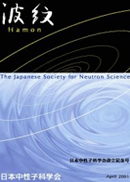
- Issue 4 Pages 154-
- Issue 3 Pages 114-
- Issue 2 Pages 66-
- Issue 1 Pages 2-
- |<
- <
- 1
- >
- >|
-
Tsukasa Miyazaki, Mikihito Takenaka2022Volume 32Issue 4 Pages 154-157
Published: November 10, 2022
Released on J-STAGE: December 01, 2023
JOURNAL FREE ACCESSThe activities and future plans of “Quantum Beam Analyses Alliance”, a project based on a new concept of industry-academia-facility collaboration, are described in detail. Unlike previous projects, this alliance focuses on one-stop use of multiple quantum beam facilities and human resource development in the participated companies.
View full abstractDownload PDF (1104K) -
Yasuhiro Yunoki, Atsushi Matsumoto, Ken Morishima, Anne Martel, Lionel ...2022Volume 32Issue 4 Pages 158-164
Published: November 10, 2022
Released on J-STAGE: December 01, 2023
JOURNAL FREE ACCESSCyanobacterial clock proteins; KaiA, KaiB and KaiC are periodically assembled into the large complex (ABC complex) in a 24-hour period in vitro. A cryo-EM study reported the structure of ABC complex. However, the locations of N-terminal domains of KaiA (AN domains) have not been resolved due to their high flexibility. For a better understanding of the assembly mechanisms, we investigated the overall structural model by integrating structural modelling based on the cryo-EM structure and small-angle X-ray/neutron scattering (SAXS/SANS) measurements. From the profiles of size exclusion chromatography (SEC)-SAXS measurements, the structural candidates of ABC complex were classified into three types (Type 1 ~ Type 3) from the viewpoint of the coordinate structure of AN domains. In order to refine the classified structures by the spatial arrangement of AN domains, we applied the SEC-inverse contrast matching (iCM)-SANS measurement to selectively observe KaiA in ABC complex which was prepared with hydrogenated KaiA along with 75%-deuterated KaiB and KaiC. The scattering from the latter components diminished and only the former component was visible in 100% D2O. By comparing the calculated SEC-iCM-SANS profiles for classified models and the experimental data, Type I were clearly the best structural model. In this report, we show the advantage of SEC-iCM-SANS measurement to resolve a large complex harboring dynamically fluctuating domains.
View full abstractDownload PDF (1091K) -
Takayuki Kumada, Daisuke Miura, Kazuhiro Akutsu-Suyama, Takayuki Oku, ...2022Volume 32Issue 4 Pages 165-168
Published: November 10, 2022
Released on J-STAGE: December 01, 2023
JOURNAL FREE ACCESSWe demonstrated the advantage of spin-contrast-variation neutron reflectometry on the structure analysis of buried interface between resin and porous silica layers. The interface structure was not reproduced by the normal Gaussian model, but by the asymmetric interface model where crosslinked polymer chains neither permeate the pore nor follow the surface roughness of the silica layer.
View full abstractDownload PDF (795K) -
Takuya Matsumoto, Norifumi L. Yamada, Fumiya Nemoto, Hideki Seto, Taka ...2022Volume 32Issue 4 Pages 169-172
Published: November 10, 2022
Released on J-STAGE: December 01, 2023
JOURNAL FREE ACCESSConventional hydrophobic surface is composed of perfluoroalkyl units including trifluoromethyl groups. Pentafluorosulfanyl group with five fluorine atoms is suspected to be a candidate of hydrophobic functional groups, comparable to trifluoromethyl group. Herein, polymers with pentafluorosulfanyl, trifluoromethyl, methyl and hydrogen groups in their side chains were synthesized and their thin films were fabricated by the spin-coating methods. Their surface free energies were evaluated from the dynamic contact angles on their polymer surfaces. The polymer thin film with pentafluorosulfanyl groups possessed the lowest surface free energy in the synthesized polymers. From the neutron reflectivity measurements of the polymer thin films in water, the affinity of polymers toward water was investigated. The thin films without hydrophobic fluorine groups in water formed swollen layers at top surface regions, while no swollen layer was observed in the thin film of polymer with pentafluorosulfanyl groups. This suggested that pentafluorosulfanyl group possessed low affinity toward water, which corresponded to high hydrophobic properties of the polymer with pentafluorosulfanyl groups. It was concluded that pentafluorosulfanyl groups were promising hydrophobic functional groups.
View full abstractDownload PDF (499K) -
Naoto Metoki2022Volume 32Issue 4 Pages 173-176
Published: November 10, 2022
Released on J-STAGE: December 01, 2023
JOURNAL FREE ACCESSNuclear spin polarization and the hyperfine splitting of Nd compounds were studied by means of neutron scattering. We can determine the magnitude of the magnetic moment from the unusual upturn of the antiferromagnetic Bragg intensities due to the interference between the nuclear spin contribution and the magnetic scattering.
View full abstractDownload PDF (557K)
- |<
- <
- 1
- >
- >|